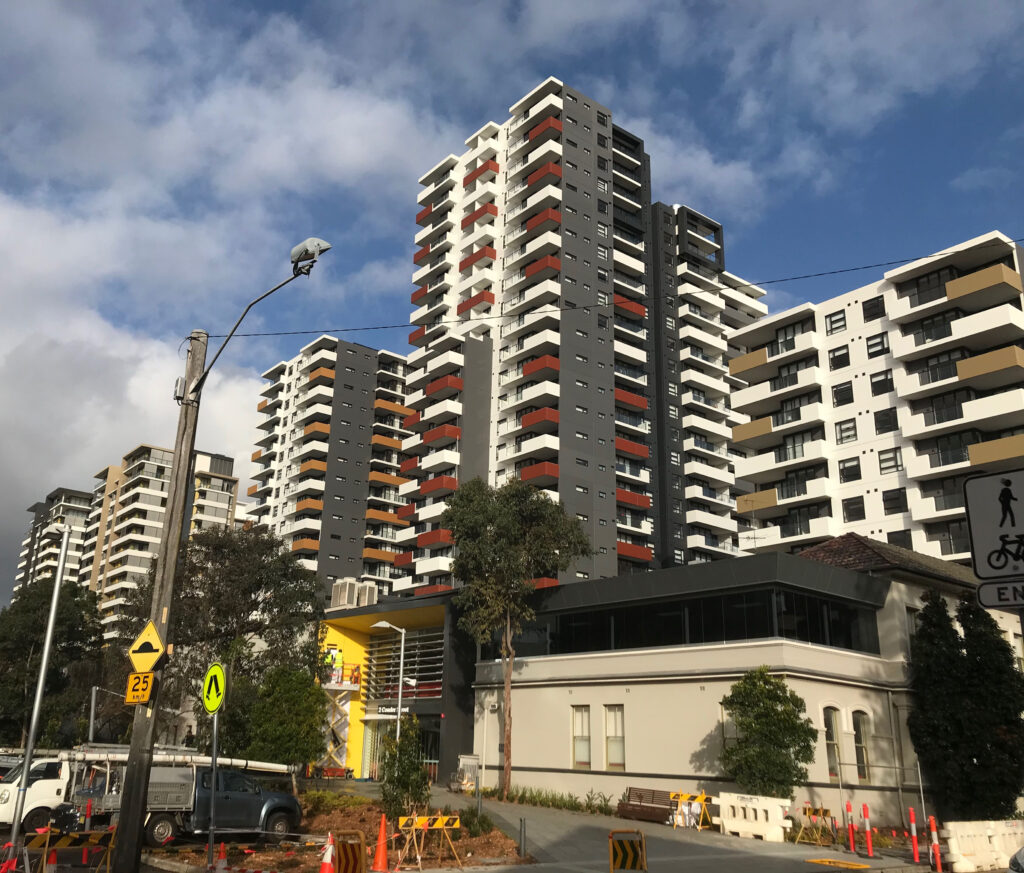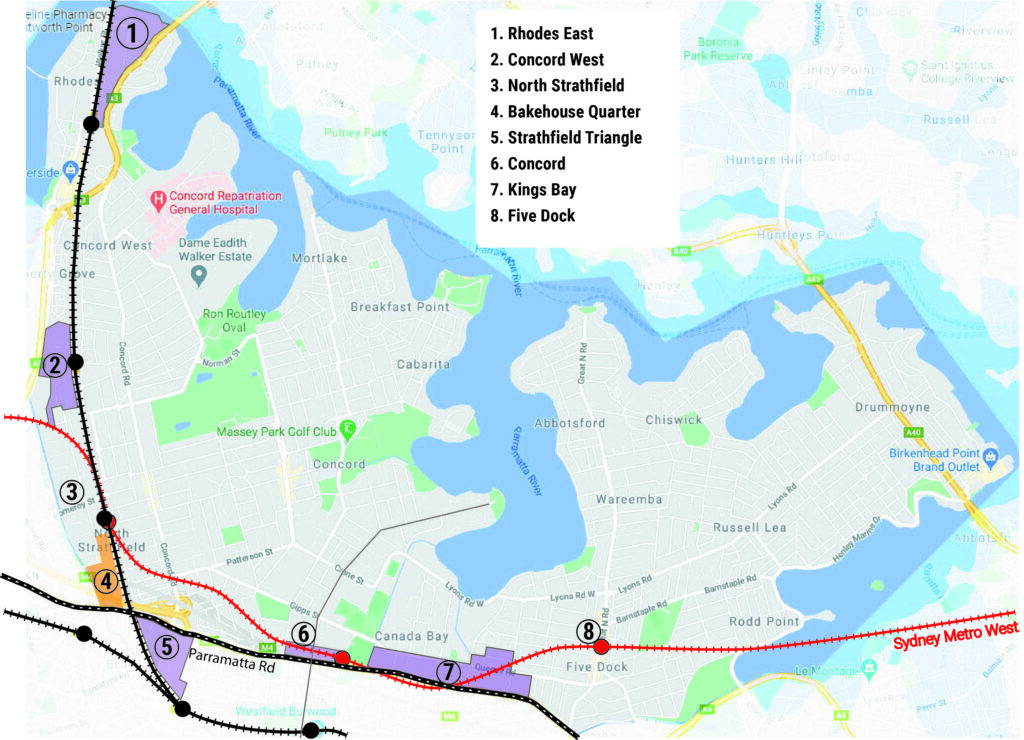by Councillor Charles Jago, Canada Bay Council

Canada Bay councillors have made a major error in approving the NSW government’s planned rezoning for high-rise towers in the Concord and Kings Bay precincts along Parramatta Road, given that infrastructure promised by the government has not been delivered. This overdevelopment leaves residents to face major problems including a substantial shortage of local high-school places and inadequate public transport.
The rezoning of these precincts is part of the NSW government’s Parramatta Road Corridor Urban Transformation Strategy, known as PRCUTS. All the precincts shown in the map below except for Rhodes and Five Dock are covered by PRCUTS. (See more on PRCUTS and the problems with it on the overdevelopment page.)

PRCUTS rezoning
Earlier this year, the NSW government instructed Council to initiate rezoning, and to produce detailed plans to implement it. It also made clear that Council would lose substantial funding if we failed to do so. Given that the government tightly constrains Council income and continually imposes new expenses on Council (cost shifting – they give us new tasks but not enough money to carry them out), Council cannot easily say no. In other words, the NSW Government has put enormous pressure on Council to get its way. They also introduced the option of spot rezoning, in which developers could ask (and often get) particular parcels of land rezoned. This would be profitable for them, but cause enormous headaches and problems in planning – this is another way for the NSW government to put pressure on Council to rezone as the government wants.
In the May meeting of Council, councillors dealt with a planning proposal to rezone precincts in Concord West (area 2 on the map, strangely called Homebush North), Concord (6) and Kings Bay (7) in line with the NSW Government’s PRCUTS program. Council staff had prepared plans implementing the rezoning. Both the Concord and Kings Bay precincts were to be rezoned with a combination of high-rise (20 storeys or more) and medium density developments. Concord West was to be rezoned, but no high-rise. More on that meeting below under the Councillor Decisions heading.
In the July Council meeting, staff presented infrastructure plans to support the rezoning, including detailed road and footpath changes, cycleways, parks and more. See the extensive paperwork included in Council meeting papers in May and July (open the meeting page then go down for the papers for each meeting date). Most of the discussion here refers to the May meeting, but the motions passed actually form a package.
Why this is not appropriate
The key issue here is that our area is already struggling to handle the population we have. People come to our area because it’s not just an attractive place, but also a good family area. But then, families find it very difficult to get their teenagers into a high-school. In addition, public transport is not keeping up. The roads are constantly jammed. The hospital upgrade is not keeping up with population growth. There is pressure on our parks to find more sporting fields. And so on.
These population pressures are already here. So when the NSW government wants more high-rise, they need to explain how they will solve these problems. Yet they have not. Rather, they have not even met the promises built into the PRCUTS plan: for a Rapid Transit system along Parramatta Road, and for planning studies to be completed before rezoning. Rapid Transit was clearly defined in the original PRCUTS papers as light rail or buses (like the T-way in the Hills area) – quite different to the Sydney Metro West train line. The Metro will be welcome, but not able to abate Parramatta Road congestion like Rapid Transit.
Councillor decisions
That’s why I voted against the rezoning motion in the May meeting, and the infrastructure motion supporting the rezoning in the July meeting. I was the only councillor to oppose them.
In the May Council meeting on this item, I raised the issue of overdevelopment, especially referring to insufficient high school places. I circulated a proposed amendment calling for a pause on the approval of the high density development. Key elements of my amendment were:
- The huge scale of targets for new dwellings imposed by the government – which Council has met.
- Critical promises in PRCUTS broken by the government.
- That the Government’s own “Local” Planning Panel for Canada Bay said the rezoning was premature.
- That high school places were insufficient to meet demand which this proposal exacerbates, despite provision in PRCUTS to address that, and that Council should complete its own study into primary and high school places, as a basis for lobbying for more, most likely including a new high school. [Coming soon: another page on this website looking at school place numbers.]
- Calling upon the government to defer the rezoning without penalty (ie not lose funding) until their promised traffic studies were complete, an outcome on resolving the deficit for school places was committed, and for the government to withdraw their threat of spot rezoning.
- Deferring approval until the government had agreed on Council’s requests.
In my previous discussions in person with other councillors, all except Mayor Angelo Tsirekas had expressed concern about the level of development, and the shortage of public high school places. Yet in the meeting, other councillors supported the rezoning with some minor additional points (items 6 – 8 in the minutes). These items were effectively letters to be written which will most likely make little or no difference. They were unwilling to challenge the NSW government’s imposed overdevelopment in any way, even though the interests of our residents are at stake.
Could Council have successfully challenged the NSW government?
It is worth stating that the NSW government is currently a minority government, with the local member under an ICAC cloud. If any time were the right time to put some pressure back on the government, that time would be now. And also, that councils are able to successfully challenge the government from time to time. For example, in 2018 Ryde Council gathered community support to put pressure on Liberal MP Victor Dominello MP to challenge the imposition of “manor houses” (usually four flats in a two-story building that could be built as “complying development”) on Ryde Council. The government withdrew the rule without difficulty.
It must be acknowledged that challenging the government is not easy. They can withhold funds in grants attached to the rezoning. The point is not to challenge the DPIE (Department of Planning, Industry and Environment) with their highly developed bureaucratic rules. (Rules that seem so rational yet strongly disadvantage communities while giving developers so much that they want.) The point is to deal with the government, who can and will change the rules at any time they find it expedient. That was the reason that my proposed amendment did not directly reject the proposal, but sought to take the matter up directly with the Minister.
In conclusion, councillors supported a proposal with excessive height and overcrowding under extreme pressure from the NSW government, when they needed instead to stand up for local residents. At the very least, councillors needed to state the seriousness of the long-term issues being locked in by the NSW government, but did not.
